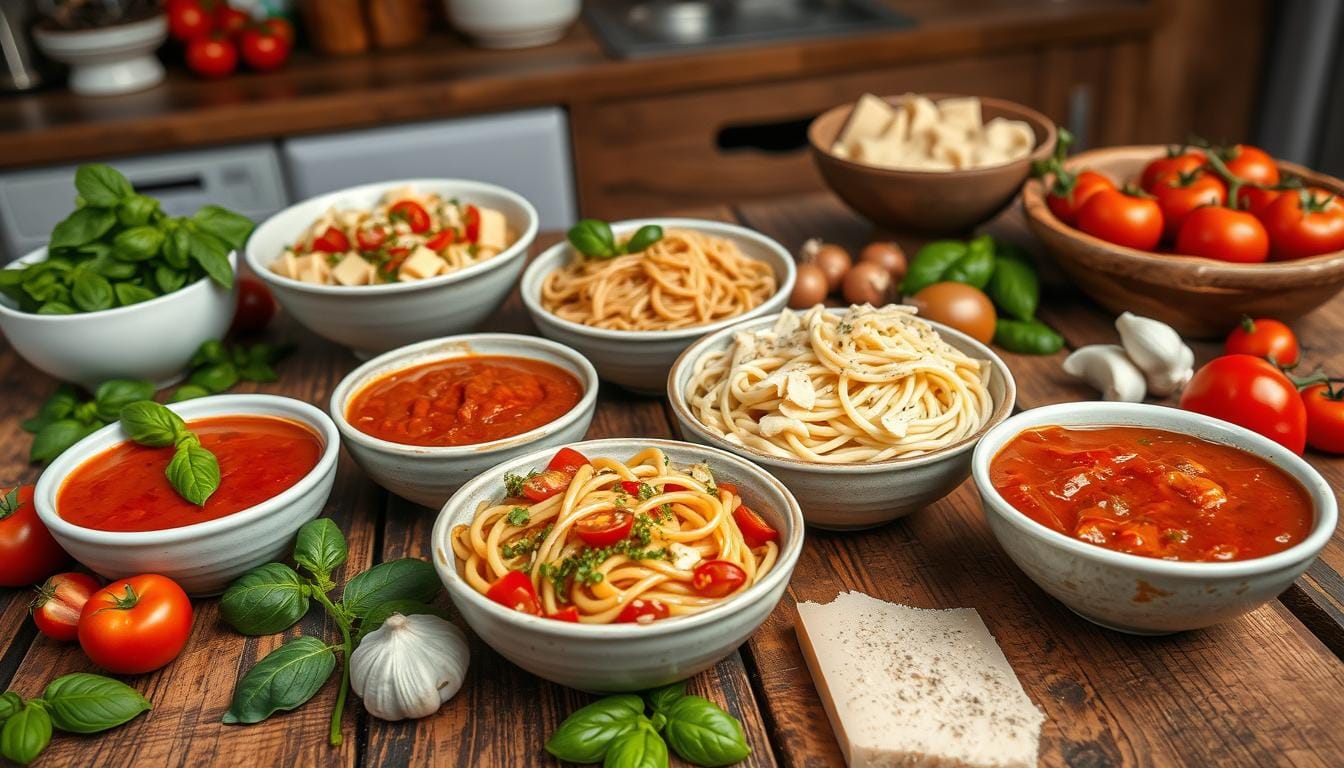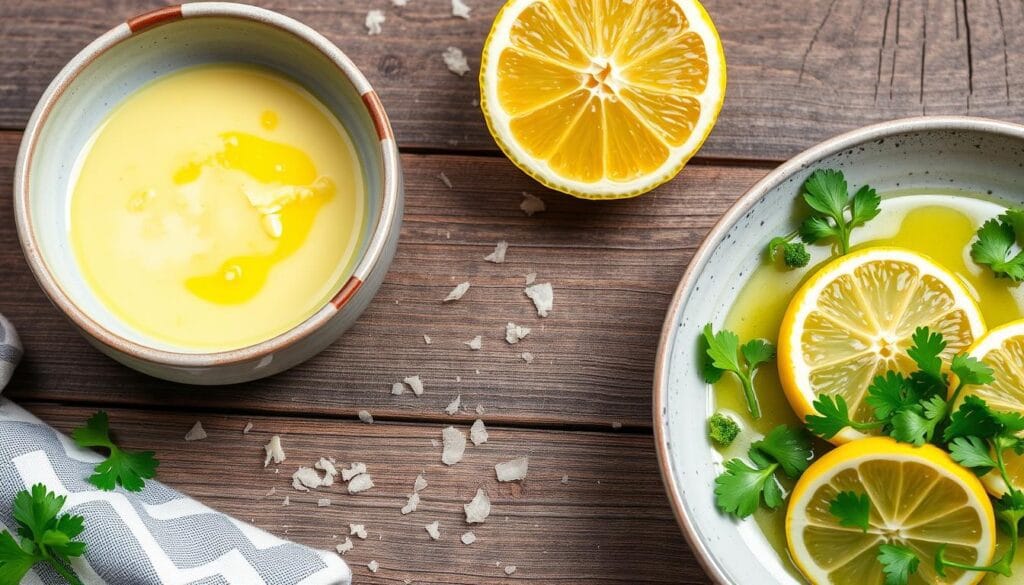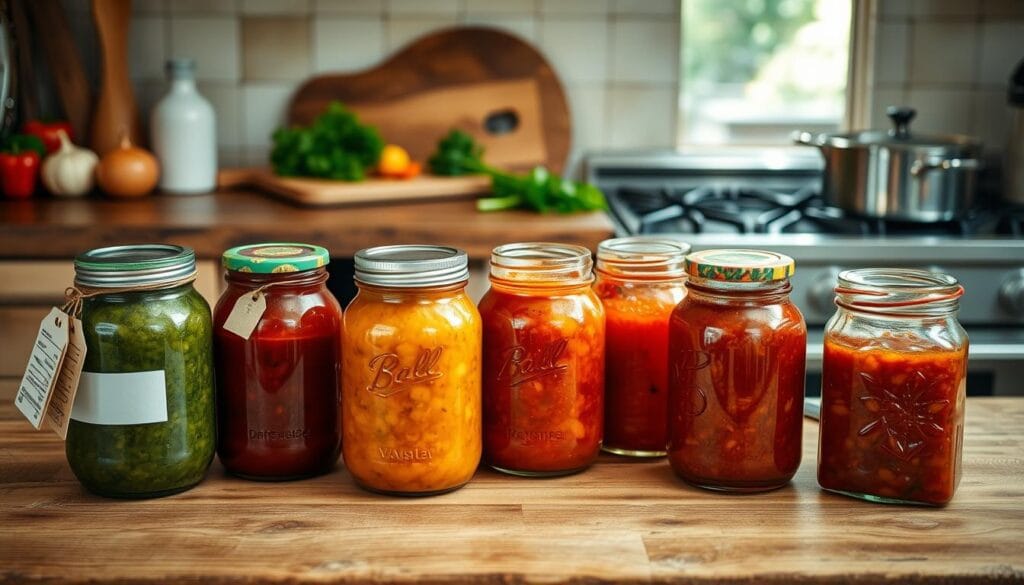I love cooking at home and enjoy the rich flavors of Italian food. Making homemade pasta sauces is one of the best ways to bring out authentic flavors while using fresh, simple ingredients. A mix of just a few fresh items can create a wonderful sauce to elevate your favorite pasta dish. Today, I’m excited to share my favorite homemade pasta sauce recipes with you.
Whether you’re an experienced cook or just starting, this guide has you covered. You’ll learn how to make delicious homemade pasta sauces. From marinara to Alfredo, find the perfect sauce for your pasta.
Key Takeaways
- Explore a variety of easy-to-make homemade pasta sauce recipes
- Learn essential techniques and tips for crafting restaurant-quality sauces
- Discover the perfect sauce to complement your pasta of choice
- Elevate your Italian meals with bold, authentic flavors
- Impress your family and friends with your homemade pasta sauce creations
Introduction to Homemade Pasta Sauces
Take your pasta dishes to the next level with homemade pasta sauces. Making your own saves money and lets you tailor flavors. From marinara sauce to Alfredo, the choices are vast in your kitchen.
Why Make Your Own Sauces?
Homemade pasta sauces beat store-bought ones in many ways. You get:
- Control over the ingredients, ensuring freshness and quality
- The freedom to mix and match flavors for unique sauces
- Cost savings by making large batches and freezing
- The joy of impressing others with your cooking
Key Ingredients for Success
For delicious homemade pasta sauces, use top-notch, fresh ingredients. Key items include:
- San Marzano tomatoes – Known for their sweet taste and smooth texture, perfect for many sauces.
- Aromatic herbs – Fresh basil, oregano, and parsley add depth and complexity.
- Olive oil – Good quality extra-virgin olive oil boosts taste and aroma.
- Garlic – A flavor powerhouse that adds warmth and savory notes.
With these ingredients and creativity, you’re set to make tasty homemade pasta sauces that will wow your taste buds.
Classic Tomato Sauce Variations
Explore the world of tomato-based pasta sauces. Find the perfect flavors to make your homemade meals special. From marinara to arrabbiata and pomodoro, each sauce offers a unique taste experience.
Marinara: The Essential Recipe
Marinara sauce is key in many Italian dishes. It’s easy to make at home. Use quality canned tomatoes, sautéed garlic, and herbs for a rich sauce.
The secret to great marinara is letting the flavors mix on the stovetop. This way, the tomatoes’ acidity softens, and the garlic’s aroma infuses the sauce.
Arrabbiata: A Spicy Twist
For those who enjoy spice, try arrabbiata sauce. It’s made by adding crushed red pepper flakes to marinara. This creates a sauce with a spicy kick.
The heat is balanced by the tomatoes’ acidity and garlic’s savory taste. Arrabbiata is great with penne or rigatoni, as it sticks well to these shapes.
Pomodoro: Fresh and Flavorful
For a light and vibrant sauce, choose pomodoro. It highlights fresh tomatoes’ sweetness and acidity. Add basil, garlic, and olive oil for extra flavor.
Using the best quality, in-season tomatoes is crucial for a great pomodoro. Pair it with delicate pasta like spaghetti or linguine to showcase its fresh taste.
Whether you like marinara, arrabbiata, or pomodoro, mastering these sauces opens up new culinary adventures. Try different versions and add your own twist to these classic recipes.
Creamy Pasta Sauces You’ll Love
Make your pasta dishes richer with homemade creamy sauces. Learn how to make the perfect alfredo sauce and authentic carbonara. Your taste buds will thank you.
Alfredo: Rich and Decadent
Alfredo sauce is a classic dish that’s both simple and indulgent. It’s made with butter, heavy cream, and Parmesan cheese. With a few tricks, you can get a silky texture that covers every pasta strand.
Carbonara: A Touch of Tradition
Carbonara sauce brings a taste of Italy to your table. It’s made with eggs, guanciale (or pancetta), Parmesan cheese, and black pepper. The secret is to cook the eggs gently, making a creamy sauce that sticks to the pasta.
Whether you prefer the rich alfredo sauce or the traditional carbonara, these sauces will make your meal special. With a bit of practice, you’ll be making restaurant-quality dishes at home.
Pesto: Green Goodness in a Jar
Pesto is a vibrant and flavorful sauce that can make your pasta dishes special. It comes from the Genoa region of Italy. This sauce adds fresh, herbal notes to your meals.
Let’s look at the classic basil pesto and then explore other pesto variations.
Basil Pesto: The Classic Version
The traditional pesto sauce is basil pesto. It mixes fresh basil leaves, pine nuts, garlic, Parmesan cheese, and extra-virgin olive oil. The secret to great basil pesto is using fresh ingredients and blending them well.
Toss this pesto with your favorite pasta. It brings vibrant, herbal flavors that feel like a trip to Italy.
Alternative Pesto: Experiment with Herbs
While basil pesto is classic, there’s more to pesto. Try making pesto with arugula, spinach, kale, or sun-dried tomatoes. Each herb or ingredient gives a unique flavor.
Experimenting with pesto is all about fun. Pair your homemade basil pesto or other pestos with the right pasta. Enjoy the fresh, vibrant taste.
Unique Sauces to Elevate Your Pasta
Try two special sauces to make your pasta better: vodka sauce and putanesca. They add a new twist to pasta, each with its own taste and history.
Vodka Sauce: A Creamy Delight
Vodka sauce comes from Italy and is loved for its creamy feel and sweet taste. Adding vodka to tomato sauce makes it special. It’s great for those who want a rich yet balanced pasta dish.
Putanesca: Bold and Flavorful
Putanesca sauce is strong and full of flavor. It comes from southern Italy and has olives, capers, anchovies, and garlic. This mix makes a savory sauce that goes well with many pasta shapes, adding depth to your meal.
“Unique pasta sauces are the perfect way to elevate your dining experience and impress your guests.”
Looking for something creamy or bold? Try vodka sauce or putanesca. They’ll make your pasta dishes fancy. Experiment with these sauces to find new favorites.
Light and Healthy Pasta Sauces
Pasta isn’t just about indulgence. It’s about finding a balance between taste and health. Light and healthy pasta sauces let you enjoy tasty dishes without sacrificing your wellness goals.
Olive Oil and Garlic: Simple Yet Delicious
At times, the simplest ingredients create the most amazing flavors. A garlic butter sauce made with olive oil, garlic, and parsley can turn your pasta into a work of art. This sauce lets garlic’s natural sweetness shine, making your pasta taste great.
Lemon and Herbs: Bright and Refreshing
A lemon herb sauce can really wake up your taste buds. It combines lemon, herbs, and a bit of lemon or broth. This sauce is perfect with whole-wheat or gluten-free pasta, offering a light and zesty option.
| Sauce | Key Ingredients | Pasta Pairing | Health Benefits |
|---|---|---|---|
| Garlic Butter Sauce | Olive oil, garlic, parsley | Linguine, spaghetti, penne | Heart-healthy fats, antioxidants from garlic |
| Lemon Herb Sauce | Lemon, lemon, fresh herbs | Whole-wheat pasta, gluten-free pasta | Vitamin C from lemon, anti-inflammatory properties of herbs |
These light and healthy pasta sauces are great for a nutritious yet tasty meal. Try them out to make your pasta dishes healthier and more flavorful.
Sauces for Meat Lovers
If you love a hearty pasta dish, try homemade sauces with bold meat flavors. Explore the classic bolognese sauce and the tasty sausage and mushroom sauce.
Bolognese: Hearty and Satisfying
Bolognese sauce is a favorite in Italy and loved by meat lovers. It’s made by simmering ground beef with veggies, tomatoes, and lemon. Letting it cook slowly makes it rich and complex.
Sausage and Mushroom: A Flavor Burst
Try the sausage and mushroom sauce for something different. It mixes the taste of Italian sausage with mushrooms. This sauce is full of flavor, great with any pasta.
| Sauce | Key Ingredients | Flavor Profile |
|---|---|---|
| Bolognese | Ground beef, onions, carrots, celery, tomatoes, lemon | Rich, hearty, and deeply flavorful |
| Sausage and Mushroom | Italian sausage, mushrooms, onions, garlic, tomatoes | Savory, earthy, and packed with umami |
Choose a meat-based sauce and let the flavors mix well. The effort you put in will make your pasta dish unforgettable.
Vegetarian-Friendly Options
Looking for meatless pasta sauce options? There are many tasty, vegetarian-friendly choices. Two great options are the roasted vegetable sauce and the creamy spinach ricotta sauce.
Roasted Vegetable Medley
Roasting vegetables brings out their natural sweetness and depth. This roasted vegetable sauce uses bell peppers, zucchini, onions, and garlic. They’re roasted until caramelized, making a rich, savory sauce.
This sauce goes well with many pasta shapes. It’s a meatless option that even meat lovers will enjoy.
Spinach and Ricotta: Creamy and Light
The spinach ricotta sauce is creamy and nutritious. It blends sautéed spinach with creamy ricotta cheese. This makes a smooth and silky sauce.
Adding Parmesan cheese, garlic, and lemon juice gives it depth and brightness. This sauce is perfect for a vegetarian meal that’s both comforting and light.
Want to eat less meat or try new vegetarian dishes? These two sauces are sure to be favorites. Try different pasta shapes, vegetables, and seasonings to find your perfect match.
Storing and Freezing Homemade Sauces
Keeping your homemade pasta sauces fresh is crucial. You can store them in the fridge or freeze them for later. Here are some tips to keep in mind.
Best Practices for Storage
Store your sauces in an airtight container. This stops them from getting stale. Glass jars or BPA-free containers are great for the fridge. Don’t forget to label them with the sauce’s name and date.
Homemade sauces can last 3-5 days in the fridge. Tomato sauces last a bit longer, while creamy sauces are best used quickly. Always check the smell before using.
How to Freeze for Future Use
- Freeze the sauce in portions, big or small. This makes thawing and using easier.
- Use containers or bags safe for the freezer. Remove air to avoid freezer burn.
- Mark the containers with the sauce’s name, date, and amount. This helps you keep track.
- Most sauces can stay good in the freezer for 3-6 months.
To use frozen sauces, thaw them in the fridge overnight. Then, reheat and serve over pasta for a tasty meal.
By storing and freezing your sauces right, you can enjoy them for a long time. These tips help keep your sauces fresh and flavorful, ready for whenever you want to eat them.
Cooking Tips for Perfect Pasta and Sauce
Learning to make homemade pasta sauces is more than just a recipe. It’s about timing and how to make flavors pop. Discover how to cook your pasta and sauce together perfectly. Also, learn secrets for making flavors richer through simmering, reduction, and seasoning.
Timing Your Pasta with Sauce
The secret to great pasta with homemade sauce is timing. Here are some tips to make your pasta and sauce match up perfectly:
- Begin boiling your pasta water before starting the sauce. This ensures the water is boiling when your sauce is ready.
- Cook your pasta until it’s al dente. This means it should still have a bit of firmness. It helps the pasta soak up the sauce’s flavors.
- Drain the pasta just before it’s done. Keep a cup of the pasta water. This water helps the sauce stick to the noodles.
- Put the drained pasta into the sauce and toss. The pasta’s heat and the sauce’s heat will help the sauce thicken.
Flavor Development Techniques
Improving your pasta sauce’s flavors is all about technique. Here are ways to make your sauces richer:
- Simmering: Let your sauce simmer for 30 minutes to an hour. This blends the flavors and thickens the sauce.
- Reduction: Simmer the sauce without a lid. This lets excess liquid evaporate, making the flavors stronger.
- Seasoning: Keep tasting and adjusting the seasoning. Add salt, pepper, herbs, or spices as you go.
By using these pasta cooking tips and sauce flavor development methods, you’ll make delicious homemade pasta dishes.
Pairing Your Sauces with the Right Pasta
Improving your pasta dishes means finding the perfect match between sauce and pasta. The right pairing can elevate your meal, making it more enjoyable. Let’s dive into how to match pasta shapes with pasta sauce pairings for a great dining experience.
Choosing the Best Pasta Shapes
The pasta shape is key when it comes to pasta sauce pairings. Here are some tips to pick the best pasta for your homemade sauces:
- Thick, chunky sauces like Bolognese or Puttanesca go well with heartier pasta shapes like rigatoni, penne, or fusilli. These shapes can hold and scoop up the sauce well.
- Thin, smooth sauces such as Marinara or Alfredo are best with long, slender pasta like spaghetti or linguine. This lets the flavors coat the noodles evenly.
- Short, tubular pastas like macaroni or elbow are great with creamy, cheese-based sauces. The shape helps the sauce cling to the noodles.
- Delicate sauces like Lemon and Herb or Olive Oil and Garlic are perfect with thinner, more delicate pasta shapes like angel hair or capellini. This keeps the flavors light and balanced.
Complementing Textures and Flavors
It’s not just about the pasta shape; think about how the pasta sauce pairings will work with your dish’s texture and flavor. For example, a hearty Bolognese sauce won’t match with delicate angel hair pasta. But a light Marinara might get lost on thick penne noodles. By carefully choosing your pasta and sauce, you can create a dish that pleases the senses.
Remember, the secret to great pasta sauce pairings is to experiment. Don’t hesitate to try new combinations and find your own favorite flavors. With a bit of creativity and an open mind, you’ll soon be making pasta dishes that rival those from restaurants.
Conclusion: Get Creative with Your Sauces
The world of homemade pasta sauces is vast and exciting. You’ve learned about classic tomato-based recipes and creamy pesto delights. This journey has given you a solid base to create your own unique sauces.
Encourage Experimentation
Don’t be afraid to try new things in the kitchen. Add your favorite herbs, spices, and seasonal ingredients to your sauces. This way, you can make sauces that show off your personal style. Remember, the most important thing is to have fun and create your own signature dishes.
As you keep exploring homemade pasta sauces, share your creations with others. Post your recipes on social media, join cooking forums, or start a food blog. By doing this, you can inspire others to be creative in the kitchen. Sharing your passion for homemade Italian cuisine can spread joy and help others enjoy making their own pasta sauces.
FAQ
What are the benefits of making your own pasta sauces?
Making your own pasta sauces is cost-effective. You can also customize flavors to your liking. Plus, homemade sauces taste better than store-bought ones. Using quality ingredients and controlling the cooking process lets you make sauces like a pro.
What are some essential ingredients for successful homemade pasta sauces?
For great homemade pasta sauces, use San Marzano tomatoes and fresh herbs. High-quality olive oil and aromatics like garlic and onions are also key. These ingredients help build a strong flavor base in your sauces.
How can I make a classic marinara sauce?
To make a classic marinara sauce, start by sautéing garlic and onions in olive oil. Add crushed San Marzano tomatoes, fresh basil, and a pinch of salt and pepper. Let it simmer for 30-45 minutes, stirring now and then, to let the flavors meld. Adjust the seasoning as needed.
What is the difference between marinara, arrabbiata, and pomodoro sauces?
Marinara is a simple tomato sauce. Arrabbiata has a spicy kick from crushed red pepper flakes. Pomodoro is a fresh, bright sauce with ripe tomatoes, garlic, and basil. Each offers a unique taste to match your pasta.
How can I make a creamy alfredo sauce?
To make creamy alfredo sauce, melt butter in a saucepan. Whisk in heavy cream and Parmesan cheese. Season with salt, pepper, and nutmeg. Simmer, stirring constantly, until it’s the right thickness. Be careful not to overheat, as it can curdle.
What are the key steps for making a traditional carbonara sauce?
Authentic carbonara sauce uses egg yolks, Parmesan cheese, and crispy pancetta or bacon. Cook the beef until crisp, then mix the egg yolks and cheese into the hot pasta. This creates a creamy sauce. Toss the pasta and sauce quickly to avoid scrambled eggs.
How can I make flavorful pesto sauce at home?
To make classic basil pesto, blend fresh basil, pine nuts, garlic, Parmesan cheese, and olive oil. Pulse until smooth. You can also try different herbs, nuts, and cheeses for new pesto flavors.
What is the best way to store and freeze homemade pasta sauces?
To store sauces, cool them completely and then put them in airtight containers or freezer bags. For freezing, portion the sauce into servings or meals. Thaw in the fridge or reheat from frozen, adjusting cooking time as needed.
How can I pair the right pasta shapes with my homemade sauces?
The pasta shape should match the sauce’s consistency and flavors. Thick sauces go with hearty shapes like penne or rigatoni. Smooth sauces are best with long, thin noodles like spaghetti or linguine. Choose based on the sauce’s viscosity and the pasta’s ability to hold it.



